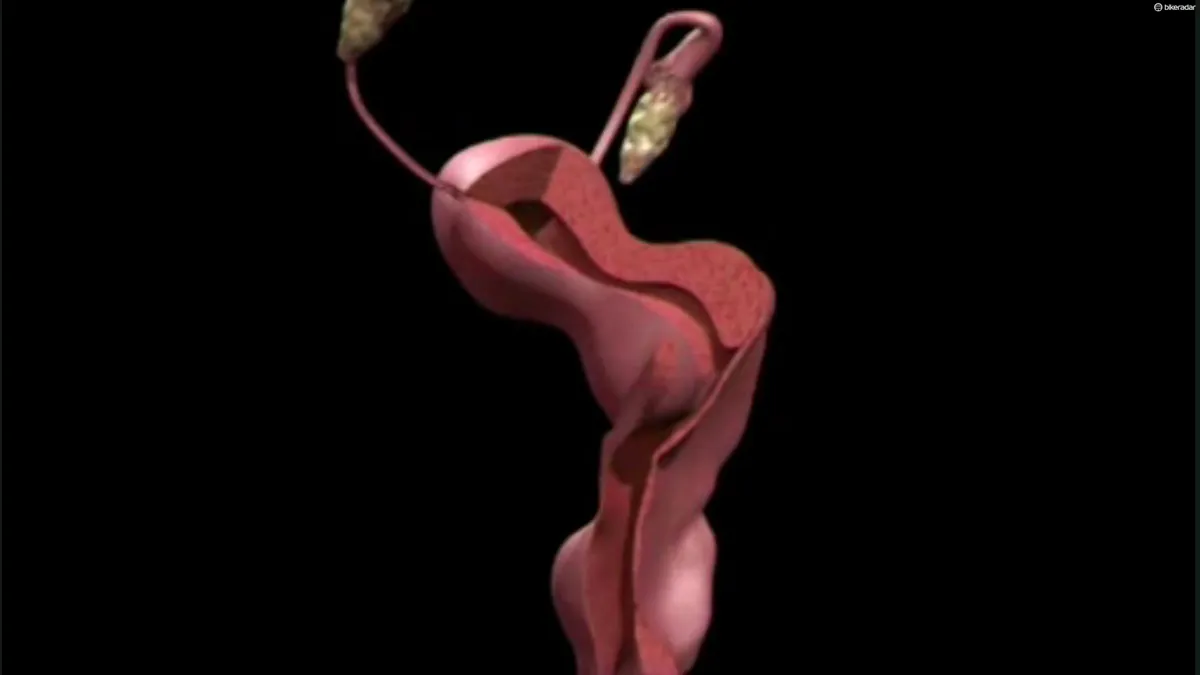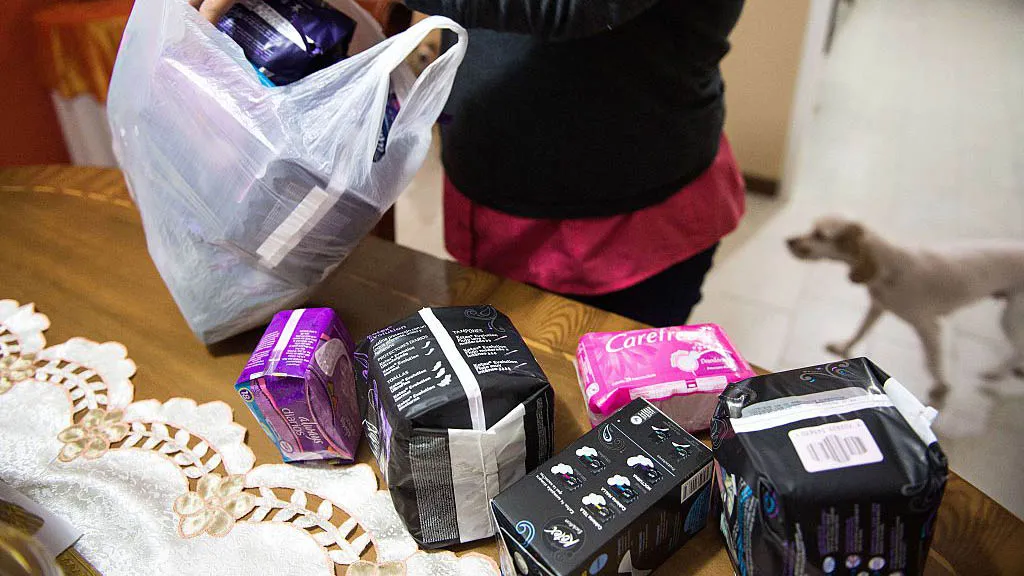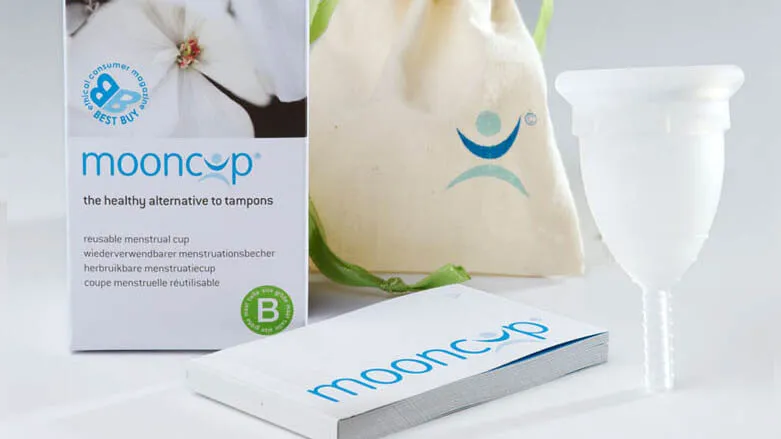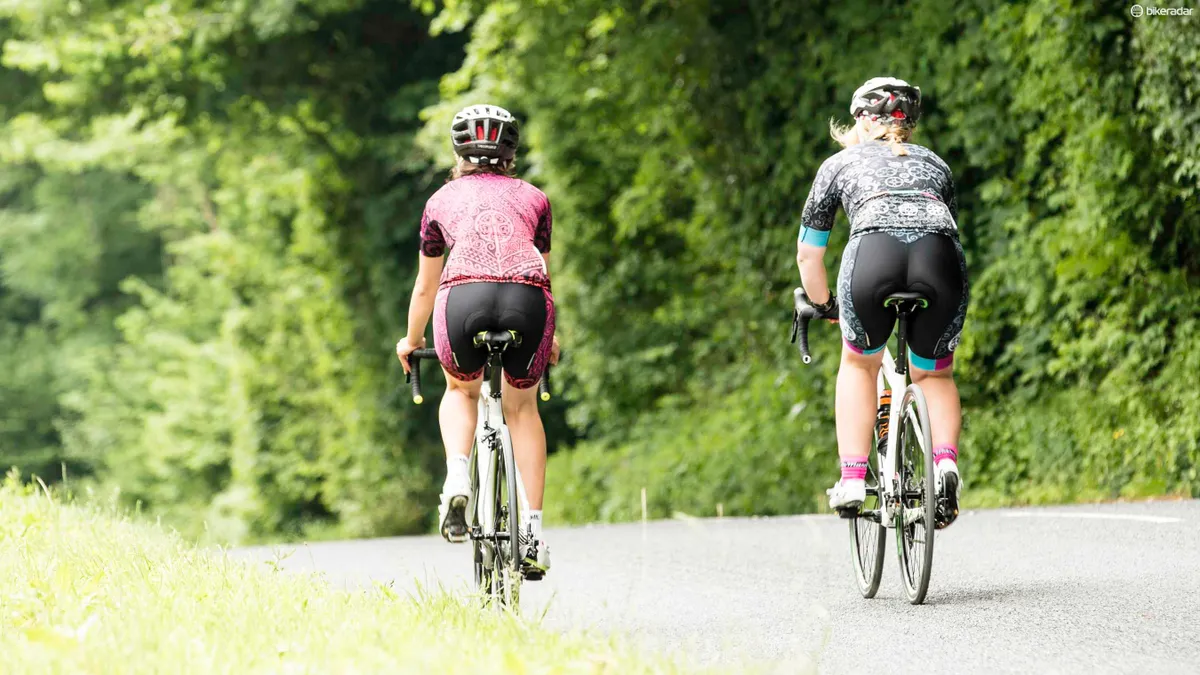The menstrual cycle, that monthly round of hormonal fluctuations, is natural, normal and something a lot of women are used to. It's also something that can, for some women, have an effect on riding — sometimes bad, sometimes good. So what exactly is going on at different points in your cycle, and can you work it to your advantage?
- What it's like to cycle while pregnant
- Best women's road bikes for 2018: 9 of the best
- Tried and tested: the best women's mountain bikes of 2018
The effects of the menstrual cycle affect women differently, but after seeing the below post on the MTB Chix & Trails Facebook page from Vicky, I started to connect the dots regarding my own experience:
“Has anyone else found that they crash more when they're riding during their period? I seem to lose spacial awareness and/or focus and this week crashed after clipping my handlebar on a tree — it turns out impaling an ovary on the handlebar is excruciatingly painful! It's not the first time that handlebar clipping has happened during my period so I'm wondering if it's linked.”
Does this sound familiar to anyone? For me it did, I had a rather impressive collection of bumps scrapes and bruises from the last week of riding and I’d put that down to trying harder than usual, but was pretty frustrated that I couldn’t stay on the bike. Looking at the dates, it was the week before my period was due. Asking various groups online, it seems that my experience is far from unusual.
Professional riders
What about professional athletes? They aren't immune to the effects of the menstrual cycle, and still have to perform to the highest level.
Riders on the Wiggle High5 Women’s Professional Cycling Team, for example, each have varying experiences and manage their cycles differently. When it comes to race day, they are able to put that aside and give it 100 percent, but as with other women that hasn't always been the case.
"I struggled a lot when I was younger," double Junior Road Race World Champion Lucy Garner tells BikeRadar. "It's hard because it's a natural thing and you can't time when it's going to come with big races and things."
Most women experience a regular cycle of hormonal fluctuations that often have physical, mental and emotional symptoms and effects. For many these are mild, for others they are more marked, but being aware of what's happening to your body and how that might affect your performance is extremely useful information.
As Garner says: "Everyone is different, and what works for someone else won't work for others."

The UK's National Health Service (NHS) website has lots of information on the menstrual cycle, including periods, PMS and pain. There's also a useful animation that describes exactly what's happening in the body during the menstrual cycle, the screen grab above from the video demonstrates how the ovaries release oestrogen.
What's going on during your menstrual cycle
Every month our menstrual cycle puts our mind and body through a rollercoaster of mental and physical changes. Knowing roughly what to expect and when could help us ride through the worst and use the hormone changes to our advantage.
Every woman is different and our cycles vary, but they can be broken down into four accepted stages based on 28 days — although many women have cycles that are longer or shorter than this, but if you have an extreme variation on this number it's worth considering consulting your doctor.
Some women also don't menstruate, due to a variety of reasons including some contraceptive methods, low body weight or illness. This is called amenorrhea. They may however still experience some of the hormonal fluctuations, even if they don't actually have a monthly bleed.
Stage 1: Days 1–7
Your period, menses or monthly bleed.
Your cycle begins on the first day of bleeding, which is when your body is getting rid of the thickened uterus lining it prepared for egg fertilisation. Bleeding usually occurs for between three and seven days.
Low oestrogen levels may mean you don’t feel like getting out for a ride, but exercise can help with cramps caused by uterine contractions.
You may find that because of the fluid increase, you’re more sensitive in the saddle — another good reason to ensure you have a comfortable one.
Stage 2: Days 7–14
This is known as the ‘golden week’. Your body is getting ready to produce another egg, so oestrogen and testosterone are on the rise. You may find that you have better reflexes and more confidence to try that drop off. You’ll feel fitter and stronger so it may be a good time for some endurance rides.
Wouldn’t it be great if we could schedule every big ride, biking holiday or race for our golden week? While that might not be possible, being aware of what's happening with your body and when can be very useful, particularly if you are an athlete.
Hannah Macleod of Great Britain's women's hockey team revealed in an interview in The Telegraph newspaper that her coach took each player's menstrual cycle into consideration with regards to training and games: "We actually had our menstrual cycles tracked by our coach for a year prior to the Olympics. It was to get an idea of what stage we'd be at during our cycles for the games."
Stage 3: Days 14–22
Ovulation occurs during the earlier days of stage three.
Your oestrogen drops as testosterone and progesterone surge and these sudden hormone changes intensify emotions and tiredness. You may find you’re more clumsy or accident prone.
Amber, another member of the MTB Chix & Trails Facebook group, shared her experience: “I have currently just had my period and had to handle a big Hamsterley XC ride and a hike-a-bike up Hellvellyn — all while camping! I can honestly say it does change me; my back hurts more, I get cramps, I feel more tired. I find it makes me a bit more emotional, so when I realised I forgot my goggles halfway up Hellvellyn, I cried! I don't feel as strong either but I remember that we're women and we can do anything so force myself to carry on.”
Stage 4: Days 22–28
You may feel bloated and have sore breasts from the high progesterone, neither of which will make you feel like getting out on the bike, but the serotonin boost you get from exercise can really help relieve PMS symptoms. Stay hydrated, eat well and lay off the caffeine and sugar.
“I try to still get out, because sometimes if I didn't I wouldn't get out at all that week," comments Gail from the MTB Chix & Trails group. "But I do feel rubbish, and don't ride as well. I take it steadier, ride within my limits, and eat cake afterwards. Cramps wise, I find exercise sometimes helps. It also helps my feeling-sorry-for-myself mood!"
Getting out and doing some kind of exercise is also what Elisa Longo-Borghini's mother recommended to her as way of dealing with her period pain: "My mother always told me that when you have your period and are in pain, training will make it less because of the endorphins."
How to manage your period while riding and racing
So, how best to deal with periods while out on a ride?
Tampons

Presuming you don’t suffer from any allergic reactions, discomfort, irritation or dryness through use, the most obvious form of sanitary protection compatible with cycling is the tampon.
With options for heavy, regular or light bleeding, most women should be able to get through a 3/4 hour ride without the need for a refresh, and they are relatively inexpensive.
On the downside, there is the very, very slight risk of Toxic Shock Syndrome, which comes with any menstrual protection system inserted into the vagina, and they do result in waste which can have an impact on the environment. You also need to ensure your hands are clean when inserting them.
Sanitary towels and pads

If you prefer to ride chamois-less then there are such things as reusable sanitary pads, and some even come with bike designs! I wouldn’t like to comment on possible chafing and rubbing though so that would be down to rider's choice.
Using sanitary pads with a chamois isn't ideal, but women who ride with regular underwear won't have this issue.
The downside for towels is that they are bulky compared to other types of sanitary protection, can move around, chafe or bunch up, and create even more waste than tampons.
Also, period blood plus sweat makes a good breeding ground for bacteria, so they're not ideal for longer rides. They often have plastic elements that don't break down in the environment and can persist for a long time in landfill, too.
Contraceptive choices that reduce or stop monthly bleeding
One way of avoiding dealing with periods while riding is to avoid having them altogether or control when they happen.
Some pill types can allow you to control when your period happens by rolling packs back-to-back. The pill can also, in some cases, lighten the flow and lessen symptoms such as reducing the heaviness of the bleed. The implant or mini pill can, in some cases, stop bleeding altogether, although you’ll need to discuss options with your GP.
Kelly, one rider we spoke to, is on the mini-pill: “I don’t have [periods] as I’m on the continued pill but I definitely have a cycle of clumsiness still. I stick to wider, less technical trails for that one clumsy week!”
Annette Edmondson of pro team Wiggle High5 finds taking the pill very effective when it comes to avoiding periods clashing with competition: "I actually manage it by being on the pill, even from a young age. I decided to go on it just before Junior Worlds because I was experiencing quite heavy [periods] and they were painful, so that's definitely regulated it and also helped me control it if it clashed with an event."
This method doesn't work for everyone, and for Claudia Lichtenberg, also with Wiggle High5, contraception as a way of controlling period symptoms wasn't an option: "I know it's quite normal to take the contraceptive pill, but for me personally I think it has a big effect on my body, so I prefer not to take them and will ride with painkillers during my period instead."
Sanitary or menstrual cups

I heartily recommend the reusable sanitary cup. These are small, flexible surgical-grade silicone cups that are inserted into the vagina to collect menstrual blood.
Shaped a little like a cup or bell with a stem, they can usually be used for four to eight hours (depending on the heaviness of the bleed) then removed, emptied, washed an reinserted. Sterilised with boiling water every month, they can last up to five years or more according to various manufacturers.
They are regarded by many as a better option since they work out cheaper than tampons or towels in the long-run, are very practical, and result in much less waste, which has less impact on the environment.
Cups come in a variety of sizes to suit different flow rates, and once you've got the hang of inserting them they are easy to use.
There are many different brands on the market, including Mooncup, Divacup, Lunette and Luna. If you're curious about what they are actually like to use, Marie Claire magazine has a great first-hand description from a first-time user. Bonus fact: Mooncup was set up by two female cyclists.
Anna, who won her Mooncup in a netball awards raffle, swears by it: "I'm not a heavy bleeder so only have to empty it once a day. It's a revelation for sport!"
Again, clean hands are needed to insert them, and they need to be washed before reinserting and there is a very slight risk of Toxic Shock Syndrome.
Free bleeding
Free bleeding, for anyone unfamiliar with the term, is where no sanitary protection is used and menses or period blood is allowed to freely flow from the body.
It is worth considering this as an option — especially for lighter bleed days — for two reasons. First, you can’t easily wear a sanitary pad in your cycling shorts, and wearing knickers under padded shorts is a definite no-no.
Second, there are such things as reusable baby nappies and what gets washed out of those is far worse that a bit of blood, so getting chamois shorts clean won't be a problem.
However, I appreciate some women may not wish to use their chamois as a built-in sanitary pad.
Apps
While they obviously don't provide actual sanitary protection, many female cyclists are now taking to technology to help track their cycles and, as a by-product, minimise the likelihood of crashing.
When you've got 101 things to remember, having something that reminds you to be more conscious of your fluid intake or when to pack painkillers in your backpack is handy indeed.
These apps are great for people who find their symptoms creep up on them, or perhaps haven't noticed the link between how they feel on the bike or their menstrual cycle.
"App trackers are brilliant. I'm dead irregular, so never know when it's going to happen but the tracker does show a bit of a pattern. I'm 40 and starting pre-menopause and I'm still surprised by period symptoms so don't worry about not twigging on!" comments Julia on the MTB Chix & Trails Facebook page.
Vicky, another mountain biker, says that's she's just started using an app: "Hopefully that will help me predict [my period] better, but I've only just twigged the link [with my cycle] — so frustrating!"
Apps such as Clue, iPeriod Tracker, Period Diary, Life, and Cycles offer a variety of features, allowing you to track and predict your menses and record your symptoms. Some offer additional functionality, such as fertility tracking and even reminders to pop out to stock up on tampons.
Working with your period
Once you know what to expect from your period, when to expect it, and have a preferred method of dealing with it, you'll be able to adapt to the way your body is working and even use it to your advantage.
Of course, different circumstances may call for different approaches, and many women find that they'll have one preferred way of managing their menstrual cycle for general riding, and a different approach for racing or longer adventures.
When you're out in the wilds for days at a time, for example, some methods of menstrual protection are more practical than others.
The team behind the Women’s Adventure Expo is currently undertaking a research project to identify and explore the issues around menstruation in extreme and challenging environments, looking at many different aspects including: the environment itself (such as mountains, deserts, jungle, marine, urban), expedition or travel duration, activities, age, health status, contraception status, cultural background, resources and practicalities in the field, including disposal or waste management.
Periods are natural, normal, and there's no right or wrong way of managing them. What's important is understanding your own body and what works for you, especially when it comes to pain management. As Amy Cure of Wiggle High5 says: "I guess there’s not really too much you can do about it, it’s just unfortunately one of those things that every female goes through, and some more than others, but I think it’s just really listening to your body and making sure you stay hydrated."
Do you have any tips or advice you'd like to share about managing your menstrual cycle while cycling? What products and apps do you recommend? Let us know in the comments below.
Additional quotes supplied by Helen Cousins.
